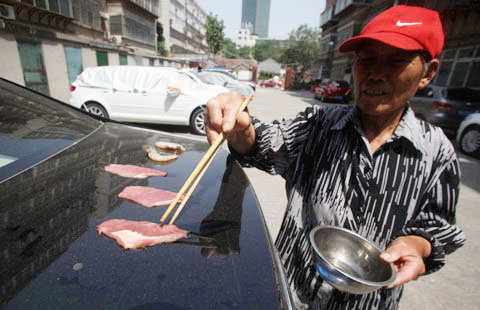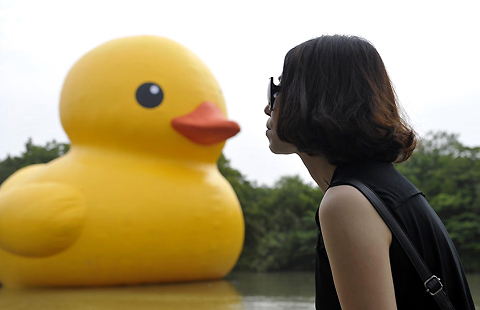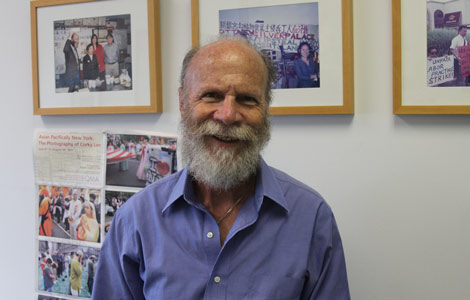Sharing talent, heritage and culture through art
Updated: 2014-05-30 12:07
By May Zhou in Houston (China Daily USA)
|
||||||||
|
Sculptor Willy Wang talks about his art at his home. May Zhou / China Daily |
At the Asian Heritage Gala hosted by the Asian Pacific American Heritage Association earlier this month, Houston sculptor Willy Wang was honored with the distinguished Outstanding Achievement Award for his artistic creations, as well as his years of service to the community by providing free art lessons to people of all ages and ethnicities.
Wang, whose sculptures grace public spaces from Beijing to Houston, from Washington to Los Angeles and other cities around the world, has been teaching artists and art lovers sketching for more than 20 years as a way of giving back to the community.
Some of Wang's works, such as Madame Sun Yat-Sen, Spring in Pamirs and Kazak Hunter, are part of the collection of the National Art Museum of China (NAMOC) in Beijing.
His sculptures stand on the campuses of Georgetown University in the east and the University of Southern California in the west. Since Houston has been his home for more than 30 years, his sculptures can be found at local parks, convention centers, hospitals, colleges and other places.
The subjects of his works include famous figures such as former president George H. W. Bush, actor Gary Grant, Chinese statesman Sun Yat-sen and Jesus Christ. But ordinary people, such as a nurse or a peasant girl, have also become marvelous art works.
His recent statue of Jesus, made for the Methodist Hospital, was so well received that a total of eight copies have been casted so far. His works in private collections are even more numerous.
Born in 1938, Wang has had a life rich with experience. His father, an engineer who studied in the US, Germany and the former Soviet Union, made extending railroads into the backlands of China his life's work, a true trailblazer of his time.
Constantly on the move, Wang saw many different parts of China growing up. "My parents have nine children and each of us was born in a different city," Wang said. "I came into contact with other ethnic people growing up."
When Wang was 5 years old, his parents took him to a Kazak event and he rendered his impression on paper: two brightly dressed Kazak girls with fluttering white feathers tucked in their hats. Pleasantly surprised and realizing his fourth child had artistic talent, Wang's father made a sketchbook for him. From then on, Wang's parents always tried their best to get pens and paints whenever possible and Wang hasn't stopped painting since.
When Wang was a teenager his family settled down in Beijing. His talent enabled him to take art lessons offered at the prestigious China Central Academy of Fine Arts (CAFA) to middle and high school students. His love of art was so great that he decided to apply to CAFA after completing high school. After rounds of tests, he was one of the seven admitted to the sculpture department in 1957, an achievement in its own.
Why sculpture? "My father had a collection of art books and I was familiar with the works of Da Vinci, Raphael and such when I was growing up," Wang said. "I found Rodin and Michelangelo most inspiring. I wanted to be like them."
After graduating with high marks, Wang worked at the prestigious Architecture Art Sculpture Company, which specialized in monumental sculpture in China. He was one of the artists who worked on the group sculpture standing on Tiananmen Square today. It was around this time that his works were collected by the NAMOC.
One of the most memorable experiences for Wang was the year he spent in Tibet in the 1970s. He became good friends with some Tibetans, learning about the history of their hardship. Some Tibetans became the subjects of his now famous Tibet series of drawings.
In 1981, Wang decided to come to the US and have a look at art in the outside world.

His first stop was Los Angeles and immediately his talent was discovered. Some public institutions and many art patrons commissioned him for sculptures as well as paintings. During that time, he did a bust for Cary Grant, which the movie star apparently loved.
One art patron in Houston was so impressed with Wang's talent he invited him to Texas. Wang went to Houston in 1983 and hasn't left since. Over the years, Wang has been creating sculptures, paintings, drawings and murals for public institutions as well as private collectors around the world.
Wang was invited to teach at Houston's Art League in 1992 when he first went to the city, and he found that many students need basic skills. He offered to teach sketching for free on weekends.
"That free class has stretched on for 22 years without stop since then," Wang said with a laugh. It even has a name: Willy Wang Workshop (WWW).
Wang, who has never been married, calls his students his big international family. It is estimated that more than 1,000 professional artists and art lovers have studied at WWW.
WWW is not just about art lessons, it's also about cultural exchange. Every year the group gathers to celebrate Chinese New Year. Wang also organizes a group trip every couple of years and China has been their most frequent destination. Wang has led his students not only to big cities like Beijing and Shanghai, but also to the Silk Road, Tibet, Pamir and other remote places.
Through the trips, students have learned what they would otherwise not be able to about Chinese history, its people and culture. Wang's contributions in creating and teaching art, and bridging cultural understanding caught the attention of Houston Mayor Annise Parker who has dubbed Wang a "cultural promoter".
Most recently, Wang embarked on a new project: donate his major art works not in private collections but to the public and build a multi-function museum to house his lifetime of work and offer education in art. It won't be easy, but Wang is determined to see it through.
mayzhou@chinadailyusa.com
(China Daily USA 05/30/2014 page11)
Most Viewed
Editor's Picks

|

|

|

|

|

|
Today's Top News
H1-B visa spouses may soon get to work in US
Obama's speech disappoints
Xi urges more jobs in Xinjiang
Singers try out for China's American Idol
China to lower market access to army equipment
Residents collect anti-terror info
Russian troops leave Ukraine border
Different styles of Zongzi
US Weekly

|

|














